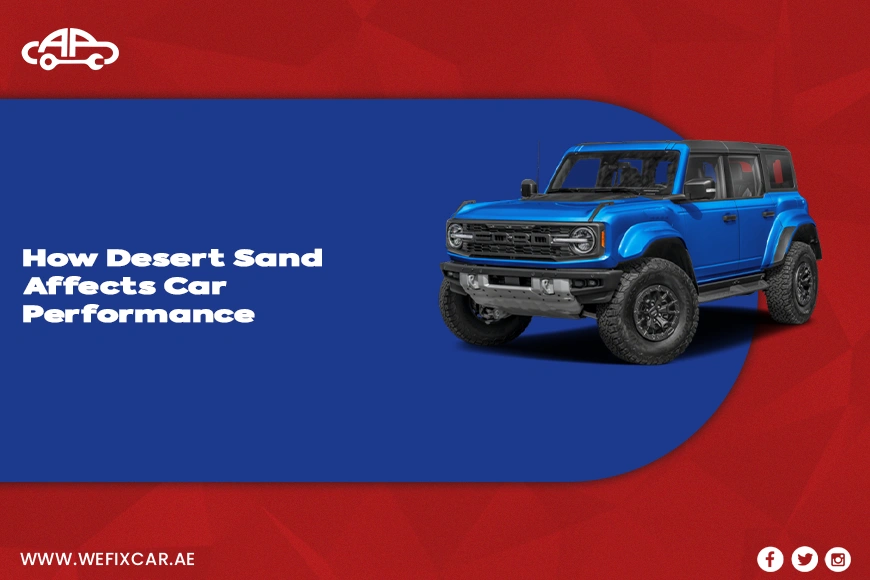Desert Sand Car Impact: How Desert Sand Affects Car Performance
Where UAE living offers you a luxurious life, on the other hand, it comes with unique challenges, especially the most overlooked is the constant vehicle exposure to desert sand. Vehicles in Dubai are constantly tested by harsh desert conditions, from sandy parking spots to dusty highways. Do you know how exactly sand affects your car performance? This blog will delve into the Desert Sand Car Impact and tips to protect your vehicle in the region’s extreme environment.
Read More: How to Increase Your Car Resale Value UAE
Desert Sand Car Impact and Tips to Reduce
Let’s get into how desert sand car impact is affecting your vehicle and how to reduce it efficiently.
Engine Performance Takes a Hit
The first place of your that the desert sand car impact is the engine. Tiny sand particles infiltrate the air intake system and can end up in the car’s engine if not properly filtered. This can result in:
- Reduced fuel efficiency
- Increased engine wear
- Blocked or dirty air filters
Places like Dubai and Abu Dhabi have sandy environments which clog the vehicle’s filter that restrict air flow and make engines harder to work. To maintain the efficiency and performance of a vehicle, you should clean or replace air filters regularly.
Damage to Car Paint and Bodywork
Desert sand is abrasive. If it is kicked by the road or blown by the wind it will act as a sand paper on your car’s paint. You will notice:
- Faded or scratched paint
- Dull exterior appearance
- Increased risk of rust in exposed areas
Apply high-quality wax and paint sealant to protect your car surface and shine. Regularly wash your car also to remove sand particles.
Air Conditioning System Blockage
Air Conditioners are a necessity not a luxury in the scorching heat of UAE. Desert sand and particles block cabin air filters that reduce the car AC performance. This can lead to:
- Weak air flow
- Foul odors
- Overworked AC compressors
We Fix Car recommend cabin air filter replacement after a major sandstorm or after every 5,000 to 10,000 km for optimal cooling.
Tyre and Brake Wear
If you are driving on sand-laden roads, it can result in additional strain on your tyres and brakes. Sand particles can lower tyre grip and sneak into the brake pads, that cause:
- Slower braking response
- Uneven brake wear
- Accelerated tyre degradation
Tyre imbalance can be the major issue which causes high fuel consumption and impacts steering control. You should check wheel alignment, inspect the tyre, and brakes to avoid this issue.
Suspension and Undercarriage Issues
Fine sand doesn’t affect visible parts of your car. This fine sands gather into the suspension system and undercarriage which can cause:
- Corrosion of metal parts
- Reduced suspension performance
- Damaged shocks and bushings
After driving through sandy areas and off-road trips, a periodic underwash is critical.
Electrical System Vulnerability
Advanced and modern technology cars variously depend on critical electric systems. As sand enter into control unit or connectors, it can cause:
- Disrupt sensor signals
- Cause engine misfires
- Lead to warning light errors
Your vehicle should undergo routine diagnostics and engine bay seals should be in good condition.
Book Now: Get Premium Car AC Service in Dubai
How to Protect Your Car from Desert Sand in UAE
Reduce the desert sand car impact with these five precautions:
- Wash your car regularly (including underbody cleaning)
- Change air and cabin filters routinely
- Park your car in shaded or covered areas
- Use car covers during sandstorms
- Schedule regular servicing at trusted workshops like We Fix Car
Why Choose We Fix Car in the UAE?
We Fix Car team understand the distinct challenges your vehicle faces in desert climates of the UAE. Our expert technicians provide personalized care whether its sand-damaged filters, AC maintenance, or tyre balancing for optimal performance and long-term protection.
Don’t wait for sand to wear your vehicle down—book your service with We Fix Car today and keep your car running smoothly, no matter how harsh the conditions.
Frequently Asked Questions—FAQs
How often should I change air filters in sandy environments?
In regions such as that in Dubai or Sharjah which have very dry and sandy climates for which your car’s air filters may see a great deal of action, we recommend you inspect the air filters at every 5,000 km and to replace them at every 10,000 km to avoid engine damage from sand.
Can desert sand damage car paints permanently?
Yes, with time desert sand car impact permanent scratch and fade in which case you should wash it off. Use of ceramic coatings or wax is a help in protection.
Does desert sand car impact tyre performance?
Absolutely, tyre performance in terms of grip and tread wear is an issue when driving in sand, particularly in the summer in the UAE. Also it is best to check tyre pressure often.
What is the best method of car care after a sandstorm?
After a sandstorm, wash your car very well before applying any soap which may scratch the paint. Also clean the underbody and wheel wells to remove that which is trapped sand.
Can sand from the desert get into the air conditioning system?
Yes, sand which is a fine grain material is a filter clog that also clogs the vents in an air conditioner, thus reducing performance and cooling ability. Routine AC service is what will keep the system at best performance.



